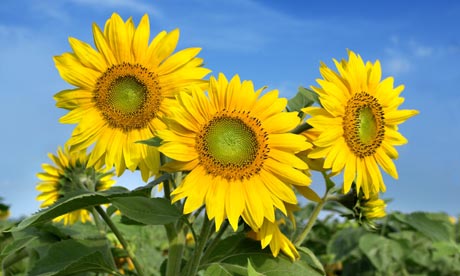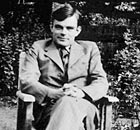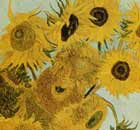Do The Guardian
Grow a sunflower to solve unfinished Alan Turing experiment
Manchester Science Festival sows the seeds of a very bright idea to honour the computer genius in his centenary year

Bright, beautiful and a mathematical puzzle: sunflowers follow the light - and maybe the Fibonacci series of numbers too. Photograph: The Travel Library/Rex Features
The whole of Manchester is being invited to plant sunflowers as part of the current centenary celebrations of his birth; and not just as a sentimental gesture.
Fittingly in the tradition of the great computer scientist, whose vital role in World War II's Enigma code-cracking was over-shadowed by his public disgrace for having gay sex, the event is practical and scientific. The Museum of Science and Industry and partners, including Manchester University where Turing made extraordinary strides in computer development after the war, are trying to conclude an experiment which he left unfinished.
 In the garden: Alan Turing Fascinated by numerical sequences and geometric patterns, Turing speculated that both the petals and densely-packed seedheads of sunflowers include striking examples of the Fibonacci number series – a mathematical phenomenon which is explained much more clearly than I could ever manage on this link here. When he was prosecuted in 1952, humiliated and put on a primitive course of hormone treatment, or chemical castration, this project joined many others in gathering dust.
In the garden: Alan Turing Fascinated by numerical sequences and geometric patterns, Turing speculated that both the petals and densely-packed seedheads of sunflowers include striking examples of the Fibonacci number series – a mathematical phenomenon which is explained much more clearly than I could ever manage on this link here. When he was prosecuted in 1952, humiliated and put on a primitive course of hormone treatment, or chemical castration, this project joined many others in gathering dust.Here's the sequence: 0, 1, 1, 2, 3, 5, 8, 13, 21, 34, 55, 89…. Can you work out the next number?
Although he had been awarded an OBE, the significance of Turing's wartime work was unknown to his colleagues at Manchester university or the public at large. His death in 1954 from cyanide poisoning has been widely assumed to have been suicide although this was never officially confirmed.His interest in Fibonacci numbers in sunflowers, and other plants, stemmed in part from his own observations and partly from his knowledge of the history of science. The excellent Turing Centenary website has a lovely drawing of him by his mother, opting out of a hockey match at school and in the words of her pencilled caption: 'watching the daisies grow.' Most daisies have 34, 55 or 89 petals – the 9th, 10th, and 11th numbers in the Fibonacci series.
 Geniuses like sunflowers. Here are some by Vincent van Gogh Turing knew about Leonardo da Vinci's interest in the subject and acknowledged the work of a Dutch scientist, J C Schoute, who studied the patterns on 319 sunflower heads just before the Second World War. That was cited in a paper Turing wrote in 1951 about patterns and sequences in biology which he also enjoyed testing on his fledgling computers.
Geniuses like sunflowers. Here are some by Vincent van Gogh Turing knew about Leonardo da Vinci's interest in the subject and acknowledged the work of a Dutch scientist, J C Schoute, who studied the patterns on 319 sunflower heads just before the Second World War. That was cited in a paper Turing wrote in 1951 about patterns and sequences in biology which he also enjoyed testing on his fledgling computers.Then it all ended. So the Turing Sunflower Project is taking it up, with a database which will be thousands strong. Professor Jonathan Swinton, a computational biologist at Manchester University, says that the numerology could be important to understanding how plants grow. He says:
Other scientists believe that Turing's explanation of why this happens in sunflowers is along the right lines but we need to test this out on a big dataset, so the more people who can grow sunflowers, the more robust the experiment.
The project's manager Erinma Ochu says:
We hope to provide the missing evidence to test Turing's little-known theories about Fibonacci numbers in sunflowers. It would be a fitting celebration of the work of Alan Turing.
The results of the experiment will be a highlight of Manchester Science Festival in October. Details on how to register for seeds are here. Tweets on progress are here, and a blog on the festival, sunflowers included, i